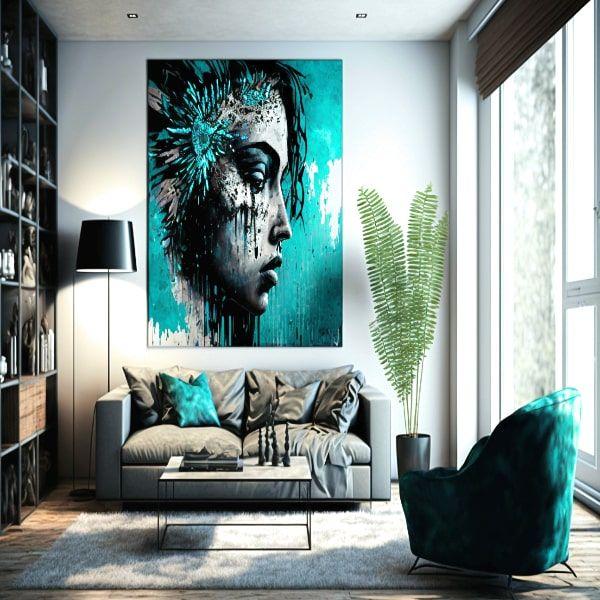Choosing the right color palette for your home is essential for creating a cohesive and aesthetically pleasing environment. The colors you choose can influence your mood, enhance your interior design, and even impact the perceived size of a room. In this comprehensive guide, we’ll explore the fundamentals of color theory and provide tips for selecting the ideal color palette for your living space.
Understanding Color Theory
Color theory is the study of how colors interact and influence one another. To choose the right color palette for your home, it’s essential to understand the basics:
- Hue: The purest form of a color (e.g., red, blue, or yellow).
- Saturation: The intensity or purity of a hue.
- Value: The lightness or darkness of a hue.
Color Harmonies
Color harmonies are combinations of colors that are visually appealing and create a sense of balance. Some common color harmonies include:
- Monochromatic: Different shades, tints, and tones of a single hue.
- Analogous: Colors that are adjacent to each other on the color wheel.
- Complementary: Colors that are opposite each other on the color wheel.
- Triadic: Three colors that are evenly spaced around the color wheel.
Tips for Choosing the Right Color Palette
Here are some practical tips to help you select the perfect color palette for your home:
- Consider your personal preferences: Start by identifying your favorite colors and the mood you want to create in your space. Learn more about decorating to improve your mood.
- Take inspiration from existing elements: Look to furniture, artwork, or other items in your home for color inspiration. Check out how to choose wall art for more ideas.
- Think about your decor style: The colors you choose should complement your overall decor style. Explore various decor styles to find the perfect match for your home.
- Use the 60-30-10 rule: Divide your color palette into three components – 60% dominant color, 30% secondary color, and 10% accent color. This helps create a balanced and visually appealing space.
- Test colors in your space: Use swatches or paint samples to see how colors look in your home’s lighting and alongside existing decor.
- Don’t be afraid to make adjustments: If a color isn’t working, don’t hesitate to modify your palette until you achieve the desired effect.
Color Palettes for Popular Interior Design Styles
Discover the perfect color palette for your favorite interior design style with our curated collection of color wheels. Each wheel features eight carefully selected hex colors that embody the essence of six popular styles, including Minimalist, Bohemian, Modern Farmhouse, Scandinavian, Coastal, and Industrial. Use these color palettes as a starting point to create a cohesive and visually appealing environment that reflects your personal taste and the desired mood of your living space. Don’t be afraid to mix and match or adjust the colors as needed to make the palette truly your own. Happy decorating!

Incorporating Colors into Your Home Decor
Once you’ve chosen your ideal color palette, it’s time to incorporate those colors into your home decor. Here are a few ideas to help you get started:
- Throw pillows: Add pops of color to your living room or bedroom with stylish throw pillows. Consider abstract throw pillows for a unique and modern touch.
- Wall art: Enhance your walls with artwork that incorporates your chosen colors. Learn more about selecting the perfect wall art for your space.
- Accent furniture: Introduce color through accent furniture, such as side tables, chairs, or ottomans.
- Rugs: Add warmth and texture to your floors with rugs that feature your chosen color palette. From bold patterns to subtle hues, rugs can make a statement and tie your room together.
- Curtains and window treatments: Enhance your windows with curtains or blinds that coordinate with your color scheme. Choose from a variety of styles and materials to find the perfect fit for your space.
- Bedding: Transform your bedroom by incorporating your color palette into your bedding. Look for duvet covers, pillowcases, and sheets that complement your chosen colors. For inspiration, check out these yellow bedroom ideas.
- Accessories: Incorporate your color scheme through smaller decor items like vases, picture frames, and decorative objects. These subtle touches can add personality and depth to your space.
Further Reading: Color Psychology in Home Decor
Once you’ve chosen your preferred color palette, dive deeper into the world of colors by exploring the impact of color psychology on your living space. Learn how different colors evoke various emotions and influence the atmosphere of your home. For a comprehensive understanding of color psychology and its practical application in home decor, check out our Color Psychology in Home Decor quick read. With this knowledge, you’ll be well-equipped to create a harmonious, visually appealing, and emotionally balanced environment that reflects your unique style.



